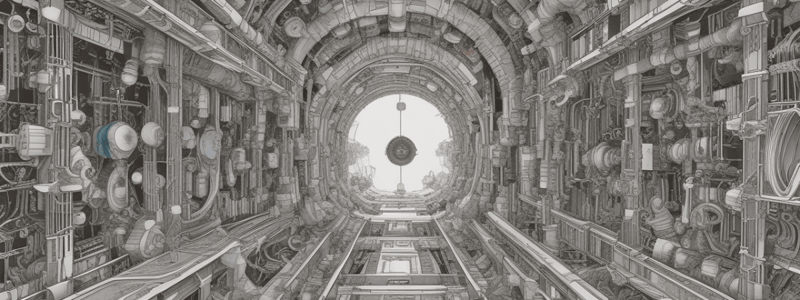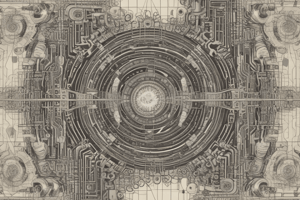Podcast
Questions and Answers
Deterministic and nondeterministic finite automata recognize the same class of ______.
Deterministic and nondeterministic finite automata recognize the same class of ______.
languages
It is surprising because NFAs appear to have more ______ than DFAs.
It is surprising because NFAs appear to have more ______ than DFAs.
power
We say that two machines are ______ if they recognize the same language.
We say that two machines are ______ if they recognize the same language.
equivalent
Every nondeterministic finite automaton has an equivalent ______ finite automaton.
Every nondeterministic finite automaton has an equivalent ______ finite automaton.
A language is regular if and only if some nondeterministic finite ______ recognizes it.
A language is regular if and only if some nondeterministic finite ______ recognizes it.
Initially, Q' = ______.
Initially, Q' = ______.
In DFA, the final state will be all the states which contain the final states of ______.
In DFA, the final state will be all the states which contain the final states of ______.
For the given transition diagram, we will first construct the ______ table.
For the given transition diagram, we will first construct the ______ table.
In the given NFA, q1 is a final state, then in DFA wherever, q1 exists that state becomes a ______.
In the given NFA, q1 is a final state, then in DFA wherever, q1 exists that state becomes a ______.
The set of final states F = { ______, [q0, q1] }
The set of final states F = { ______, [q0, q1] }
To convert NFA with ε to DFA, we will take the ε-closure for the ______ state of NFA as a starting state of DFA.
To convert NFA with ε to DFA, we will take the ε-closure for the ______ state of NFA as a starting state of DFA.
Step 2 involves finding the states for each input symbol that can be traversed from the present ______.
Step 2 involves finding the states for each input symbol that can be traversed from the present ______.
Mark the states of DFA as a final state which contains the ______ state of NFA.
Mark the states of DFA as a final state which contains the ______ state of NFA.
The ε-closure {q0} = { ______, q1, q2 }
The ε-closure {q0} = { ______, q1, q2 }
For state C, δ'(C, 0) = ε-closure {δ(q4, ______)}
For state C, δ'(C, 0) = ε-closure {δ(q4, ______)}
The transition table for the constructed DFA will include states like ______, q1, and [q0, q1].
The transition table for the constructed DFA will include states like ______, q1, and [q0, q1].
The δ' transition for state q1 is obtained as: δ'([q1], 0) = [q1, ____]
The δ' transition for state q1 is obtained as: δ'([q1], 0) = [q1, ____]
The state [q1, ____] is the final state as well because it contains a final state q2.
The state [q1, ____] is the final state as well because it contains a final state q2.
In the transition table, the transition from state [q0] with input 1 goes to state ____.
In the transition table, the transition from state [q0] with input 1 goes to state ____.
The transition table for the constructed DFA consists of four states: [q0], [q1], [____], and [q1, q2].
The transition table for the constructed DFA consists of four states: [q0], [q1], [____], and [q1, q2].
The δ' transition for state q2 is obtained as: δ'(__, 0) = [].
The δ' transition for state q2 is obtained as: δ'(__, 0) = [].
Now we will obtain δ' transition on [____, q1].
Now we will obtain δ' transition on [____, q1].
The transition for state [q1] with input 0 results in ____.
The transition for state [q1] with input 0 results in ____.
The transition diagram is used to convert from NFA to ____.
The transition diagram is used to convert from NFA to ____.
States containing ______ as its component are treated as final states of the DFA.
States containing ______ as its component are treated as final states of the DFA.
The transition table for the given Non-Deterministic Finite Automata (NFA) begins with state ______.
The transition table for the given Non-Deterministic Finite Automata (NFA) begins with state ______.
The new state {q1, ______} is added to Q'.
The new state {q1, ______} is added to Q'.
The transition table T' has a transition from state q0 on input '0' that leads to ______.
The transition table T' has a transition from state q0 on input '0' that leads to ______.
For the DFA, the transition table on alphabet '1' for state ______ is *{q1, q2}.
For the DFA, the transition table on alphabet '1' for state ______ is *{q1, q2}.
The state {q1, q2} leads to ______ when the input is 'a'.
The state {q1, q2} leads to ______ when the input is 'a'.
The new set of states of the Deterministic Finite Automata (DFA) is represented as ______.
The new set of states of the Deterministic Finite Automata (DFA) is represented as ______.
The start state of the DFA is ______.
The start state of the DFA is ______.
The ε-closure of state q0 is {q0, q1, ______}
The ε-closure of state q0 is {q0, q1, ______}
In the DFA, state A corresponds to the ε-closure of q0, which is {q0, ______, q2}
In the DFA, state A corresponds to the ε-closure of q0, which is {q0, ______, q2}
The transition δ'(A, 0) equals ______
The transition δ'(A, 0) equals ______
The set B is defined as {q1, ______} in which the state q2 lies.
The set B is defined as {q1, ______} in which the state q2 lies.
In the transition table T', if the transition of start state over some input alphabet is ______, then perform the transition to a dead state.
In the transition table T', if the transition of start state over some input alphabet is ______, then perform the transition to a dead state.
The final state for A corresponds to the state ______.
The final state for A corresponds to the state ______.
The new set of states for the DFA is represented by ______.
The new set of states for the DFA is represented by ______.
The transition table of the DFA is denoted by ______.
The transition table of the DFA is denoted by ______.
Flashcards are hidden until you start studying
Study Notes
Equivalence of NFAs and DFAs
- Deterministic Finite Automata (DFAs) and Nondeterministic Finite Automata (NFAs) recognize the same class of languages, highlighting their equivalence.
- NFAs may seem more powerful than DFAs due to their flexibility in transitioning between states, but both recognize the same set of regular languages.
- NFAs can be easier to construct for certain languages, making them a useful alternative in some contexts.
- Two machines are defined as equivalent if they recognize the same language.
Theorem 1.39
- Every Nondeterministic Finite Automaton has an equivalent Deterministic Finite Automaton.
- This theorem affirms that any NFA can be transformed into a DFA, providing a method of characterizing regular languages with NFAs.
Corollary 1.40
- A language is considered regular if at least one NFA recognizes it, emphasizing the significance of NFAs in the study of regular languages.
Steps for Converting NFA to DFA
- Step 1: Start with an empty set of states, Q' = ϕ.
- Step 2: Add the start state of the NFA, q0, to Q', and identify transitions from this state.
- Step 3: For each input symbol, find possible sets of states; if a new set is found, include it in Q'.
- Step 4: Define the final states of the DFA as those that include any final states of the NFA.
Example of NFA to DFA Conversion
- Transition table outlines states and their transitions based on input symbols.
- The δ-transition function determines how states evolve based on input, showcasing new state generation in the DFA.
Steps for Converting NFA with ε to DFA
- Step 1: Compute ε-closure of the starting state of the NFA.
- Step 2: For each current state of the DFA, find all states reachable via input symbols and their closures.
- Step 3: Continue this process until all states have been added to the transition table.
- Step 4: Mark DFA states containing any NFA final states as final states of the DFA.
Example of NFA with ε to DFA Conversion
- Identify ε-closures for each state to establish equivalent DFA states based on reachable states.
- Utilize δ-transition to define transitions for each input, ensuring all valid pathways are represented.
General Converting NFA to DFA Steps
- Draw the original NFA transition table to establish reference points.
- Create a new set of states Q' for the DFA and an empty transition table T'.
- For null transitions in the NFA, map them to a dead state in the DFA.
- Populate the new transition table with derived states until no new states remain.
- Designate states containing NFA final states as final states in the DFA's transition table.
These notes summarize the process of converting NFAs to DFAs, highlighting the importance of understanding both types of automata in the theory of computation.
Studying That Suits You
Use AI to generate personalized quizzes and flashcards to suit your learning preferences.




